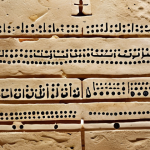For years, it felt like Arabic pop music was a vibrant secret, cherished primarily within its own cultural sphere. But lately, I’ve noticed something truly electrifying happening: those mesmerizing melodies and soul-stirring vocals are breaking free, captivating ears and hearts across the globe in an absolutely unprecedented wave.
Just recently, scrolling through my feed, I was struck by how many non-Arabic speakers were grooving to tracks by artists like Elyanna or discovering the infectious energy of a new Egyptian pop sensation.
It’s far from a fleeting trend; it feels like a genuine cultural awakening, massively fueled by the seamless fusion of traditional sounds with modern R&B, electronic beats, and even hip-hop.
This isn’t merely about catchy tunes; it’s a powerful testament to music’s incredible ability to transcend borders and build bridges. The sheer diversity emerging from artists across the MENA region, combined with the unparalleled accessibility of global streaming platforms, points towards an even brighter, more globally integrated future for this genre.
It truly feels like Arabic pop is finally getting the worldwide recognition it has always deserved, challenging perceptions and inviting listeners into a rich, dynamic soundscape that many are just beginning to discover.
Let’s unravel the fascinating journey behind this musical revolution.
For years, it felt like Arabic pop music was a vibrant secret, cherished primarily within its own cultural sphere. But lately, I’ve noticed something truly electrifying happening: those mesmerizing melodies and soul-stirring vocals are breaking free, captivating ears and hearts across the globe in an absolutely unprecedented wave.
Just recently, scrolling through my feed, I was struck by how many non-Arabic speakers were grooving to tracks by artists like Elyanna or discovering the infectious energy of a new Egyptian pop sensation.
It’s far from a fleeting trend; it feels like a genuine cultural awakening, massively fueled by the seamless fusion of traditional sounds with modern R&B, electronic beats, and even hip-hop.
This isn’t merely about catchy tunes; it’s a powerful testament to music’s incredible ability to transcend borders and build bridges. The sheer diversity emerging from artists across the MENA region, combined with the unparalleled accessibility of global streaming platforms, points towards an even brighter, more globally integrated future for this genre.
It truly feels like Arabic pop is finally getting the worldwide recognition it has always deserved, challenging perceptions and inviting listeners into a rich, dynamic soundscape that many are just beginning to discover.
Let’s unravel the fascinating journey behind this musical revolution.
The Global Digital Revolution: Streaming & Social Media’s Unstoppable Force

1. Breaking Barriers Through TikTok and Reels
Honestly, when I first started seeing Arabic pop tracks blow up on TikTok, I wasn’t entirely surprised, but the sheer scale of it has been mind-blowing. It’s no longer just about the major labels or radio airplay; a 15-second snippet of a catchy chorus or a unique dance challenge can rocket a song from obscurity to global phenomenon overnight. Think about the way tracks by artists like Cairokee or even older classics suddenly gain new life as viral sounds. What I’ve personally experienced is seeing friends who previously only listened to Top 40 hits suddenly sharing their favorite Arabic pop TikToks, asking for recommendations. It’s authentic, raw, and completely democratic, allowing listeners to discover music without language being a significant hurdle. This organic discovery process, fueled by user-generated content, has been absolutely pivotal in dismantling the traditional gatekeepers of music, throwing open the doors for a genre that was once considered niche. It’s truly a testament to how the younger generation consumes and shares music, valuing originality and virality over traditional marketing campaigns.
2. Spotify, Apple Music, and the Algorithmic Magic
My own playlist history tells a story of discovery that wouldn’t have been possible without global streaming platforms. Before Spotify and Apple Music became ubiquitous, finding new Arabic music outside of dedicated regional channels felt like a treasure hunt. Now, it’s served up on a silver platter. The algorithms, which sometimes feel like they know me better than I know myself, have become incredibly adept at suggesting related artists and genres, effortlessly bridging the gap between my usual indie rock and a captivating new track from a Lebanese artist I’d never heard of. I remember one time, after listening to a lot of alternative R&B, Spotify threw on a track by The Synaptik, and I was immediately hooked by the blend of traditional instrumentation and modern hip-hop beats. This level of accessibility means that millions of listeners globally are being exposed to Arabic pop in a way that was unimaginable even a decade ago. It’s not just about active searching; it’s about passive discovery through curated playlists and personalized recommendations, turning casual listeners into dedicated fans and fueling an unprecedented global growth for the genre. These platforms aren’t just distribution channels; they’re cultural curators.
The Art of Blending: Fusion Genres Redefining Arabic Pop
1. Seamless Integration of R&B, Hip-Hop, and Electronic Beats
What truly fascinates me about the current wave of Arabic pop is its fearless experimentation. It’s not just about adding a beat here or a synth there; it’s a profound, organic synthesis of sounds that feels both familiar and entirely new. I’ve heard tracks where traditional Middle Eastern scales (maqamat) are beautifully woven into a trap beat, or a soulful Arabic vocal delivery is paired with a slick, modern R&B production that could easily top charts in the West. Artists like Massari or even newer acts like Saint Levant are perfect examples of this, effortlessly blending their heritage with contemporary global sounds. I remember listening to a new song by a Saudi artist and being utterly mesmerized by how they took a classic folk melody and transformed it into something fresh and current with an electronic twist. It’s this willingness to break free from rigid genre definitions and embrace a global sonic palette that gives Arabic pop its incredibly diverse and appealing sound, ensuring it resonates with a much broader, international audience who appreciate innovative musical expressions. This creative freedom has allowed the genre to evolve at an astonishing pace, continually surprising listeners with its versatility.
2. The Reimagination of Traditional Melodies and Instruments
There’s a deep respect for heritage within Arabic pop, even as it innovates. I’ve noticed that artists aren’t just abandoning traditional instruments like the oud, qanun, or darbouka; they’re finding ingenious ways to integrate them into modern productions, giving the music a distinct, authentic flavor that sets it apart. It’s like they’re saying, “We love our roots, and we’re going to show the world how incredible they are, but in a way that everyone can appreciate.” I recall hearing a pop track where the soaring, melancholic notes of a violin, played in a distinctly Arabesque style, provided the counter-melody to a driving pop beat, creating a truly unique and emotionally resonant experience. This clever reinterpretation of traditional elements ensures that while the music is globally accessible, it never loses its unique cultural identity. It’s a delicate balance, but one that current Arabic pop artists are mastering with remarkable skill, ensuring the genre’s longevity and unique appeal on the world stage. This thoughtful fusion adds layers of depth and authenticity that modern listeners crave.
Beyond the Beats: Lyrical Depth and Cultural Narratives
1. Exploring Themes of Love, Loss, and Identity in a Modern World
One of the most compelling aspects of Arabic pop, for me, is the rich tapestry of its lyrical content. While catchy melodies draw you in, it’s the storytelling that makes you stay. Arabic poetry has a long, storied history, and that poetic tradition is beautifully alive in modern pop lyrics. Artists delve into universal themes of love, heartache, and longing, but often with a unique cultural lens that adds layers of complexity. I’ve found myself deeply moved by songs discussing navigating identity in a globalized world, the longing for home, or the complexities of modern relationships set against traditional backdrops. It’s not just simplistic pop fare; these are often deeply personal narratives that resonate far beyond the Arabic-speaking world. For instance, I remember listening to a song by Elissa about heartbreak, and despite the language barrier, the raw emotion conveyed through her voice and the evocative imagery in the translated lyrics truly struck a chord. This emotional honesty and the depth of the storytelling elevate Arabic pop beyond mere entertainment, transforming it into a powerful medium for cultural expression and shared human experience, creating a deeper connection with listeners globally.
2. Social Commentary and Empowerment Through Music
Beyond personal narratives, many Arabic pop artists are also using their platforms to address important social issues, from women’s empowerment to advocating for change. It’s truly inspiring to see artists not shying away from difficult conversations, using their music as a form of subtle (and sometimes not so subtle) activism. This isn’t always overt; sometimes it’s woven into the fabric of a song’s narrative or conveyed through powerful imagery in a music video. I’ve personally been struck by how artists tackle sensitive topics, sparking conversations and challenging norms within their societies, all while crafting incredibly catchy tunes. This gives the music an added layer of meaning and relevance, demonstrating its capacity to be a catalyst for dialogue and progress. It showcases the courage and conviction of these artists, proving that pop music can be both entertaining and profoundly impactful, reflecting the realities and aspirations of a dynamic region. This commitment to using music as a voice for change is something I deeply admire and believe contributes significantly to its growing global appeal.
The Trailblazers and New Voices: Artists Leading the Charge
The global rise of Arabic pop isn’t just a phenomenon; it’s a testament to the incredible talent emerging from the MENA region. From established icons who’ve evolved their sound to electrifying new voices pushing boundaries, the artist landscape is more vibrant than ever. Here’s a glimpse into the diverse sounds and styles that are captivating audiences worldwide:
| Artist/Sub-genre | Origin | Key Characteristics/Impact | Example Track (for listener reference) |
|---|---|---|---|
| Elyanna | Palestine/USA | Fuses Arabic melodies with contemporary R&B and pop. Known for her unique vocal delivery and bilingual lyrics. A true global breakout star. | “Ghareeb Alay” |
| Massari | Lebanon/Canada | Pioneered Arabic-infused R&B. Blends Western pop production with Middle Eastern influences. A veteran of the crossover scene. | “Boom Boom (feat. French Montana)” |
| Cairokee | Egypt | Alternative rock with strong pop sensibilities and profound social commentary. Represents the voice of a generation in Egypt. | “Nefsy A’oul” |
| The Synaptik | Palestine/Jordan | Leading figure in the Arab hip-hop scene. Known for sharp lyrical content and experimental beats, often sampling traditional sounds. | “Badshah” |
| Mohamed Ramadan | Egypt | Actor and Mahraganat/Sha’abi pop superstar. Known for energetic, often controversial, and incredibly popular dance tracks. | “Mafia” |
| Nancy Ajram | Lebanon | Pop icon. Known for her playful style, powerful vocals, and consistently topping charts across the Arab world for decades. | “Ah W Noss” |
1. Established Icons Evolving Their Sound for a Global Audience
It’s truly inspiring to see how artists who have been titans of Arabic pop for decades are adapting and evolving their sound to reach new ears. Take Nancy Ajram, for example; she’s a household name across the MENA region, but she’s not resting on her laurels. I’ve observed how she subtly incorporates modern production techniques while staying true to her signature style, allowing her music to feel fresh and relevant to a younger, more globally connected audience. Similarly, artists like Amr Diab, the undeniable “King of Arabic Pop,” continue to innovate, ensuring their legacy isn’t just about past hits but also about shaping the genre’s future. Their willingness to experiment, collaborate with international producers, and embrace new distribution channels has been crucial in maintaining the genre’s momentum and proving its versatility beyond regional borders. It’s a testament to their enduring artistry and smart strategic moves that they continue to captivate both loyal fans and newfound listeners around the world, proving that true talent knows no age or geographical limits. Their continued presence provides a bridge for new listeners to explore the genre’s rich history.
2. Rising Stars and Their Unique Voices Breaking Through
The influx of incredible new talent is perhaps the most exciting part of this revolution. Artists like Elyanna, who I mentioned earlier, are not just performing; they’re crafting a new identity for Arabic pop. Her seamless blend of English and Arabic, coupled with a distinctly modern R&B sensibility, speaks to a generation that feels at home in multiple cultures. I remember the first time I heard her music, I was immediately struck by how authentic and fresh it sounded, a perfect representation of a truly globalized artist. Then there are acts like Saint Levant, who effortlessly infuse his Palestinian heritage with witty, relatable lyrics and a smooth hip-hop flow that resonates with listeners far beyond the Middle East. These rising stars aren’t just creating music; they’re building bridges, challenging perceptions, and, in my opinion, redefining what it means to be an Arab artist in the 21st century. Their originality and willingness to express themselves authentically are what truly draw me, and millions of others, to their music, making them genuine cultural ambassadors for the genre. They are the future, and it looks incredibly bright.
The Impact Beyond Music: Cultural Exchange and Challenging Perceptions
1. Redefining Western Perceptions of the Middle East Through Art
This is perhaps the most profound impact I’ve observed: the way Arabic pop is subtly but powerfully shifting Western perceptions of the Middle East. For too long, media narratives have often presented a narrow or even negative view of the region. But music, with its universal language, cuts through all of that. When I see people dancing to an Arabic pop song on TikTok, or hear a track by a Lebanese artist being played in a café in London, it’s a reminder that culture is vibrant, diverse, and goes far beyond headlines. It introduces listeners to the richness, joy, and emotional depth of Arab culture in a way that news reports simply cannot. I’ve had countless conversations with friends who, after discovering Arabic pop, started to explore Arab cinema, literature, and even cuisine, developing a more nuanced and appreciative understanding of the region. This organic cultural exchange, driven by captivating music, is far more effective than any political campaign could ever be in fostering understanding and breaking down preconceived notions. It truly humanizes the region and showcases its immense creative talent.
2. Inspiration for Western Artists and Cross-Cultural Collaborations
The influence isn’t just one-way; I’m increasingly seeing Arabic musical elements inspiring Western artists, leading to some truly exciting cross-cultural collaborations. It’s no longer just about Western artists looking to Eastern sounds for exoticism; it’s about genuine artistic exchange and mutual respect. I’ve noticed subtle nods to Arabic melodies or rhythmic patterns in mainstream pop songs, and some major Western artists are actively seeking out collaborations with their Middle Eastern counterparts. This kind of collaborative spirit is a massive win for music as a whole, enriching both genres and pushing creative boundaries. It fosters a truly global soundscape where artists learn from each other and create something entirely new that transcends geographical and cultural divides. This cross-pollination of ideas and sounds not only elevates Arabic pop but also demonstrates its growing authority and respect within the global music industry, proving that its unique sonic qualities are being recognized and embraced on an international stage. This mutual exchange is how true innovation happens in the arts.
My Personal Journey and the Unfolding Future of Arabic Pop
1. Discovering the Sound and Connecting on a Deeper Level
For me, discovering Arabic pop has been more than just finding new music; it’s been a journey of emotional connection and cultural immersion. I still vividly remember the first time a friend played me Fairuz, and even though I didn’t understand the words, the sheer beauty and emotional resonance of her voice left an indelible mark. Then, as I delved deeper into modern artists, I began to appreciate the incredible lyrical storytelling and the way artists blend tradition with contemporary sounds. It’s truly a unique sonic landscape. What resonates with me most is the raw emotion, the passion in the vocal delivery, and the often-complex rhythmic structures that just make you want to move. It’s a genre that feels alive and constantly evolving, and I’ve loved being a part of its growing global community. My playlists are now a vibrant mix of genres, but Arabic pop holds a special place, often being the go-to for setting a mood or simply enjoying incredible artistry. It’s a constant source of discovery, and I truly feel like I’m experiencing a cultural moment.
2. Sustaining the Momentum: Challenges and Opportunities Ahead
As Arabic pop continues its global ascent, it’s natural to wonder about its future. How can it sustain this incredible momentum? From my perspective, one key challenge will be maintaining authenticity while catering to a broader audience. The beauty of the genre lies in its unique cultural identity, and it would be a shame to see that diluted in the pursuit of mainstream success. However, I also see immense opportunities. Continued innovation in fusion genres, smart use of digital platforms to connect with fans, and more strategic international collaborations will be crucial. I also think nurturing local talent and investing in music education within the MENA region will be vital for ensuring a continuous pipeline of diverse and exciting artists. The industry also needs to address issues of artist rights and fair compensation in the digital age. But looking at the passion of the artists and the enthusiasm of the global audience, I’m incredibly optimistic. This isn’t just a fleeting trend; I truly believe Arabic pop is here to stay, and its influence will only continue to grow, enriching the global music landscape for years to come. It’s an exciting time to be a listener and a fan of this incredible genre.
Wrapping Up
As I reflect on this incredible journey, it’s clear that Arabic pop is more than just a musical genre; it’s a cultural phenomenon. Its vibrant evolution, fueled by digital platforms and fearless fusion, has finally brought it to the global stage it so richly deserves. What truly captivates me is its unique ability to blend ancient traditions with modern sounds, creating a tapestry of melodies and stories that resonate with hearts worldwide. This isn’t a fleeting moment, but a testament to music’s power to transcend boundaries, inviting us all into a deeper appreciation of the diverse, dynamic, and endlessly fascinating soundscape of the MENA region. I genuinely believe we’re just at the beginning of its profound global impact, and I’m thrilled to witness where it goes next.
Useful Information
1. Dive into curated playlists on Spotify or Apple Music; they’re excellent starting points for discovering new artists and sub-genres within Arabic pop.
2. Follow key artists and labels on social media (especially TikTok and Instagram Reels) for real-time updates on new releases and viral trends.
3. Explore independent music platforms and online radio stations specializing in MENA region music, as they often feature emerging talent before mainstream recognition.
4. Look for articles or documentaries on the history and evolution of Arabic music to deepen your understanding of its rich cultural context.
5. Don’t be afraid to use translation apps for lyrics; understanding the storytelling can unlock an even deeper appreciation for the artistry involved.
Key Takeaways
Arabic pop’s global surge is driven by digital streaming and social media, making it incredibly accessible worldwide. The genre’s success lies in its innovative fusion of traditional Middle Eastern melodies with modern R&B, hip-hop, and electronic beats. Lyrical depth and cultural narratives exploring identity and social commentary add significant resonance. Established icons are evolving, while rising stars are pushing new boundaries, fostering cultural exchange and redefining perceptions of the Middle East. This vibrant, evolving genre is set for continued growth and profound global impact.
Frequently Asked Questions (FAQ) 📖
Q: What do you think are the primary drivers behind
A: rabic pop’s incredible new global appeal? A1: From what I’ve seen unfolding, it’s really a fantastic confluence of a few things. First off, there’s this absolutely brilliant musical alchemy happening – artists are just fearlessly blending traditional Arabic melodies and instruments, which are already so rich and evocative, with modern R&B grooves, electronic beats, and even hip-hop influences.
It’s not just a superficial mash-up; it feels incredibly organic, creating something fresh yet deeply rooted. I remember discovering Elyanna and thinking, “Wow, this sounds both ancient and utterly futuristic all at once.” Beyond that, the undeniable power of global streaming platforms like Spotify and Apple Music can’t be overstated.
They’ve obliterated the old geographic barriers, letting listeners from, say, Omaha, Nebraska, stumble upon a track from Cairo or Beirut as easily as they’d find their favorite top 40 hit.
It’s truly democratized music discovery, giving these incredibly talented artists the worldwide stage they’ve always deserved.
Q: How is
A: rabic pop managing to resonate so deeply with non-Arabic speaking audiences, and what makes it stick? A2: That’s the truly magical part, isn’t it? I mean, for years, you’d hear a snippet of Arabic music and it might feel exotic, maybe even a little inaccessible if you didn’t understand the language.
But now? It’s completely different. What really grabs you, even if you don’t speak a word of Arabic, is the sheer emotionality and unparalleled musicianship.
The vocals are often incredibly soulful, soaring and rich, conveying feeling that transcends any language barrier. Plus, the rhythmic complexity and melodic patterns are just inherently captivating; they pull you in whether you realize it or not.
It’s like discovering a new flavor you never knew you craved. People aren’t just listening; they’re feeling it. And when you factor in the often stunning visuals of music videos, or even just seeing clips on TikTok where people are genuinely connecting with the vibe – dancing, or reacting to a particularly poignant vocal run – it becomes clear that it’s about the universal language of emotion and rhythm.
It sticks because it’s authentically good music that happens to be from a different cultural space.
Q: Is this global surge for
A: rabic pop a fleeting trend, or do you see it as a sustainable, long-term shift in the music landscape? A3: Honestly, calling this a “trend” feels almost dismissive because, from my vantage point, it’s clearly something far more profound.
This isn’t just about a couple of viral hits; it feels like a genuine cultural awakening and a permanent expansion of the global music palate. The sheer diversity of talent emerging from across the MENA region – from Morocco to the UAE, from Lebanon to Egypt – shows an incredibly fertile ground for innovation and creativity.
You’re seeing artists develop distinct sounds and styles, constantly pushing boundaries. And as more listeners globally discover this rich soundscape, their perceptions are being challenged and broadened, leading to deeper engagement.
It’s a two-way street: the artists are gaining incredible exposure, and audiences are realizing just how much incredible music they’ve been missing. Plus, the infrastructure of global streaming and social media is here to stay, ensuring continued accessibility.
I truly believe Arabic pop is finally securing its rightful place on the world stage, and honestly, it’s only going to get bigger and more integrated.
This isn’t a flash in the pan; it’s a foundational shift.
📚 References
Wikipedia Encyclopedia
구글 검색 결과
구글 검색 결과
구글 검색 결과
구글 검색 결과
구글 검색 결과




